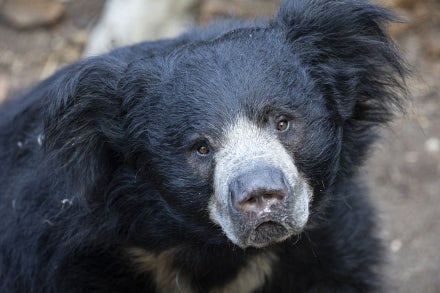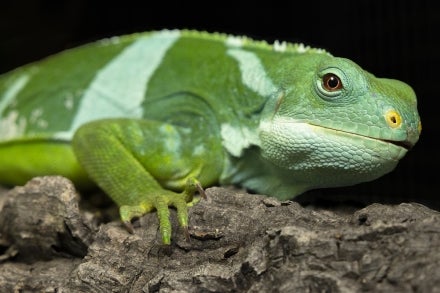Image

 Number of rock iguana subspecies in the West Indies.
Number of rock iguana subspecies in the West Indies.
 SLEEPING BAG PHASE
SLEEPING BAG PHASEHatching is exhausting business! Some iguanas rest just out of the shell in a “sleeping bag phase” for a day or two.[/caption]
 Jamaican iguanas hatched at the San Diego Zoo Institute for Conservation Research since 1996.
Jamaican iguanas hatched at the San Diego Zoo Institute for Conservation Research since 1996.
 MIGHTY HERBIVORE
MIGHTY HERBIVOREJamaican iguanas were thought to be extinct since the 1940s, but a tiny population was rediscovered in 1990. They remain critically endangered.[/caption]
 Approximately how many days the eggs incubate.
Approximately how many days the eggs incubate.
Size Matters
The latest little scaled wonders were a long time coming. “We have worked with this species since 1996, when we got our first hatchlings from the Hope Zoo in Kingston, Jamaica,” said Jeff. The original animals were very difficult to breed, and none of the zoos in the program had any success. In 2006, the Indianapolis Zoo was the first to produce viable eggs of this species. Four of those offspring came to the Institute for Conservation Research, where Jeff devoted much attention and ingenuity to their care—they are the parents of the latest Jamaican iguana hatchlings. “Females gravid [pregnant] for the first time can have infertile eggs or produce smaller clutches,” explained Jeff. Jamaican iguanas grow continuously throughout their life, and the larger she is, the better she is at nesting and producing viable eggs. A fully grown female iguana may lay up to 15 eggs per clutch, while a young, smaller female will lay 2 to 4 eggs. “We provide them the best nest material—deep soil and options for heat and moisture—that we can here at the Griffin Center,” said Jeff. “If we fail them, they can’t nest properly.” [caption id="attachment_124566" align="aligncenter" width="900"] HEADSTART
HEADSTARTCollaboration between 12 US zoos and the Jamaica people and government is helping this species rebound. San Diego Zoo Global is pleased that four of its eggs from 2 different clutches successfully hatched in 2017.[/caption]
 Number of feet in length a full-grown Jamaican iguana can reach.
Number of feet in length a full-grown Jamaican iguana can reach.
 EGGING THEM ON
EGGING THEM ONJeff Lemm took this telling photo of the eggs laid at the Reptile Conservation Center in 2017: Light-colored eggs have developing hatchlings; darker eggs are infertile. Females lay their eggs from May to June, digging a nest in the soil and covering the leathery eggs with leaves. She will guard her nest for up to two weeks. Hatchlings emerge in about 85 days.[/caption]
 Number of headstarted iguanas released in Jamaica.
Number of headstarted iguanas released in Jamaica.
Wild Side
Jamaican iguanas, the largest native animal in Jamaica, are found only in the dwindling tropical dry forests of the Hellshire Hills outside Kingston, Jamaica. This striking species was thought to be extinct in the 1940s, as it had not been seen in the wild for years. But in 1990, a pig hunter’s dog found a Jamaican iguana and it was brought to the Hope Zoo in Kingston. This discovery piqued the interest of local people, and a survey was conducted of the Hellshire Hills, which revealed a small population of fewer than 100 individuals of this iconic reptile. Researchers at the University of the West Indies began a large-scale, cooperative program to save this rediscovered species, which San Diego Zoo Global and other accredited zoos have been a part of from the start. [caption id="attachment_124568" align="aligncenter" width="900"] STARTING OUT SMALL
STARTING OUT SMALLThis pint-sized reptile may reach three feet in length and weigh about 15 pounds in adulthood.[/caption] Like all successful conservation projects, a multipronged approach is needed. Solutions to the ongoing deforestation of the area—as well as threats from non-native animals including mongooses, cats, dogs, and pigs—need to be tackled. Collecting eggs and raising the baby iguanas until they are large enough to fend off predators has proven effective—about 350 Jamaican iguanas head-started at the Hope Zoo in Kingston have been released into the forest have bolstered the wild population, leading to a sixfold increase in nesting females since 1990. However, one little change in their environment could cause them to go extinct, as the last stronghold for this species is a few square miles in Hellshire Hills. While they are not “fuzzy megafauna,” the Jamaican iguana is a crucial seed disperser to its native forest. “Every species has a purpose,” said Jeff. “Hopefully, people will realize that reptiles need conservation love, too.”




